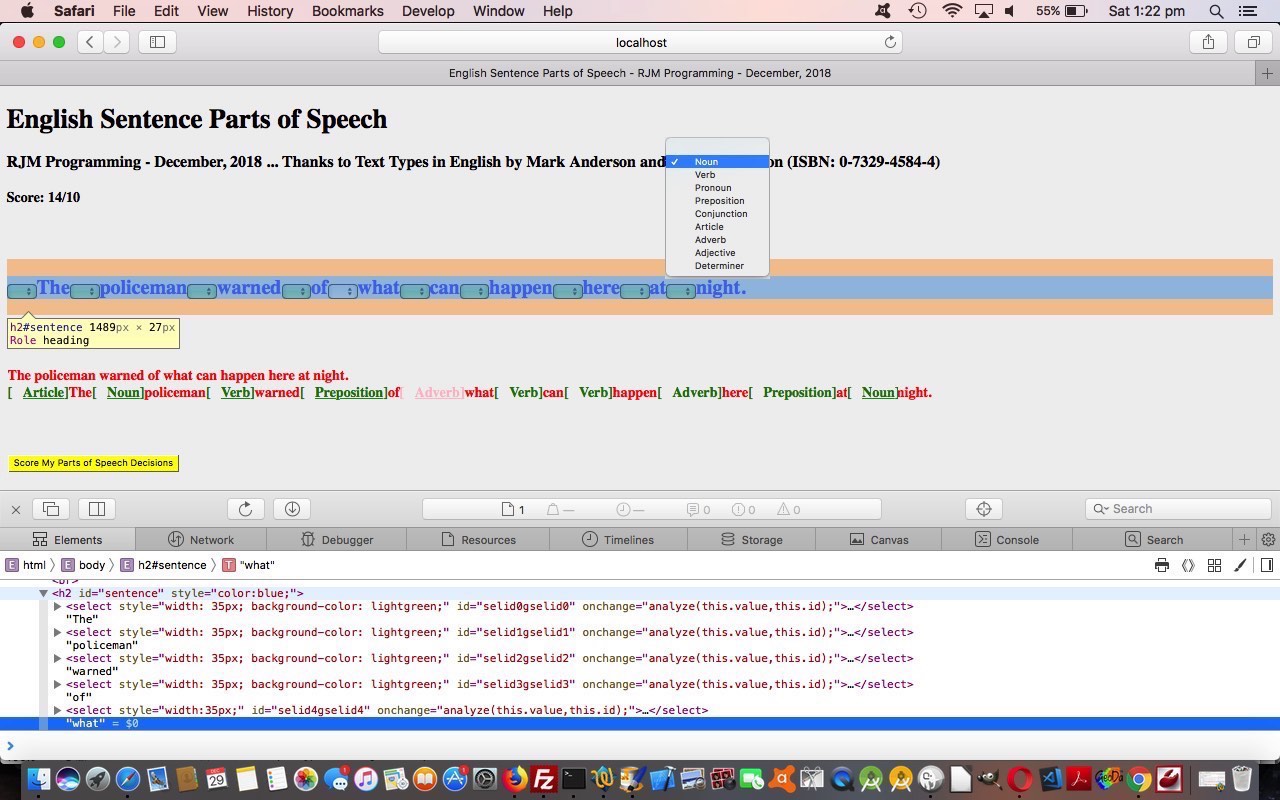Yesterday’s ESL English Clause Primer Tutorial was an opportunity to think about other web application ideas that could benefit from that design of HTML and Javascript code. Today’s “Parts of Speech” (ESL) game came about by …
- start with code of “Clauses” (ESL) game and change mentions of “Clauses” with “Parts of Speech” … and …
- leave sentence parts of “sentences” array as is … changing just the …
- controller parts (bits after “|”) have one less dimension of comma separated values (the last one goes … hence …
for (var i=0; i<=blankbasis.length; i++) {
// question display creation logic all the same as last time here
}
- new selbit array of “Parts of Speech” types … and …
- changed result set linking logic to reflect user helping logic for “Parts of Speech” rather than “Clauses” information
) … and all values become non-null indexes to …
Far more “what we have in common” than “what divides us” in our books (and all second hand pamphlettes). Of course, the other choice here is to just have the one code source for both and change “Clauses” hard codings into HTML select (dropdown) element selected items, a tactic you will see a lot from us over the years. Not today though. English grammar alert: no verb detected. No worries, let me explain. Sentences can have “implied verbs”. We could say with “Not today though.” we implied “Not today though do we apply this tactic.” Think yourself, getting into English, especially spoken English, and we do this a lot, even substituting words with hand indications or body language. Fact remains though, an action is being referenced for even these sentences without a “written down” verb.
In today’s web application parts_of_speech.html‘s game, ideally suited to ESL students, we ask the user to try to see what “part of speech” of each word of a sentence is, in terms of …
| Part of Speech type | Definition |
|---|---|
| Verb | Verbs are the word or words that tell what the subject does or is, being the action, doing or having words. |
| Noun | Nouns are the word or words to represent a person, place, thing or idea. |
| Pronoun | Pronouns are words that stand in place of a noun. |
| Preposition | Prepositions are words used after a noun or pronoun that indicates its relation to another word in the sentence. |
| Adverb | Adverbs are words or phrases that modify the meaning of an adjective, verb, or other adverb, expressing manner, place, time, or degree. |
| Adjective | Adjective are words naming an attribute of a noun or pronoun. |
| Determiner | Determiners are modifying words that determines the kind of reference to a noun or noun group. |
| Conjunction | Conjunctions are words used to connect clauses or sentences or to coordinate words in the same clause. |
| Article | Articles are words used to modify a noun, which is a person, place, object, or idea. |
Previous relevant ESL English Clause Primer Tutorial is shown below.
An English sentence is a wonderful and flexible part of the English language. In essence, most sentences we express in English, can be broken up into clauses, which are, to quote Text Types in English by Mark Anderson and Kathy Anderson (ISBN: 0-7329-4584-4) …
A clause is a complete thought expressed in words. It must include a verb or verb group.
… to the extent that a single principal clause can become an entire sentence, which fits in with an adage we were taught at school, that “all English sentences contain a verb”.
In today’s web application clauses.html‘s game, ideally suited to ESL students, we ask the user to try to see where clauses start and end within sentences, and along the way the user may learn a bit more about …
| Clause type | Definition |
|---|---|
| Principal clause | A principal clause contains a finite verb and has meaning on its own. |
| Subordinate clause | A subordinate clause contains a finite verb and has no meaning on its own. |
| Noun (subordinate) clause | A noun (subordinate) clause can be the subject or object of a sentence. |
| Adjectival (subordinate) clause | Adjectival (subordinate) clauses provide information on the person, place or thing that they are associated with. |
| Adverbial (subordinate) clause | Adverbial (subordinate) clauses are like adverbs, providing information about the action. |
Maybe it will straighten out a few things in your mind about how English works!
If this was interesting you may be interested in this too.
If this was interesting you may be interested in this too.




